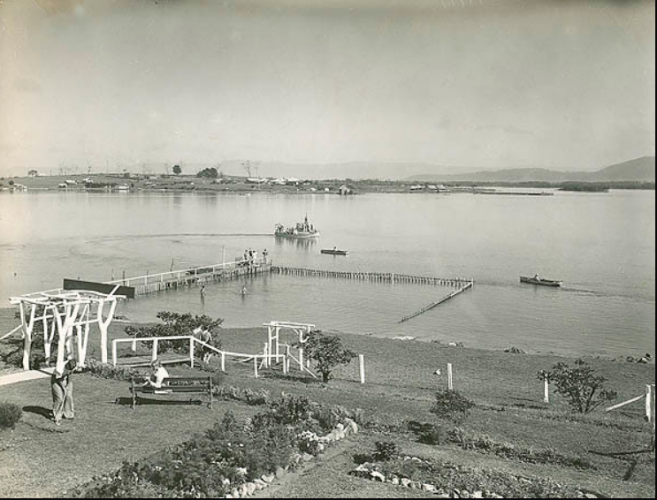South Coast NSW History Story
GREENWELL POINT
Greenwell Point was developed and thrived as the principal port for the Coolangatta Estate and then for the wider Shoalhaven area.
It was named after an Aboriginal doctor, ‘Greenwell’, who was well-known for being able to treat snakebites and toothache.
Some histories suggest that the area originally belonged to a retired naval surgeon, Dr William Elyard, who swapped it in 1829 with Alexander Berry of the Coolangatta Estate for land at Brundee (between Nowra and Pyree). Elyard certainly owned Orchard Farm at Brundee (also known as Berrellan, which explains the name of one street in Greenwell Point) from 1838 to 1850; and Berry constructed a wharf using convict labour at Greenwell Point in August 1829.
It seems the first settlement at Greenwell Point occurred around 1835.
Greenwell Point was an ideal location for ships to berth and load. It was just up from the mouth of the Crookhaven River, so provided some shelter for shipping from the open sea and, with the construction of Berry’s Canal linking the Shoalhaven and Crookhaven Rivers, it served the small vessels that worked both rivers. The wharf at Greenwell Point was to become the Shoalhaven River’s main wharf.
Alexander Berry not only built the wharf, but provided mooring chains across the shipping channel that would be picked up by dropping the ship’s anchor as a vessel approached the wharf (an anchor that was at the seaward end of this braking chain is preserved in Anzac Park). He also provided a ketch, the Gimboli, that transported produce from his tenants’ farms to the wharf, and constructed the road linking Numbaa to Greenwell Point.
Over time, buildings such as storehouses were constructed near the wharf. And in June 1865 Thomas Mann, who surveyed Nowra township, surveyed the road from Nowra to Greenwell Point. In 1866 a steamer service was operating on the Shoalhaven River from Greenwell Point to Terara.
At around this time, the Greenwell Point area had a population of about 50 and was exhibiting signs of permanency. In 1870 the Greenwell Point Public School was opened with an enrolment of 20 children (it closed in 1939 because of low enrolments, but reopened in 1954), and in 1879 the Greenwell Point Post Office was opened.
By 1872 the southern arm of the Crookhaven River had been opened to large steamers and within a year Greenwell Point had become the fourth busiest port in the state after Sydney, Wollongong and Newcastle. So, that same year, local boatmen erected a light tower at the nearby entrance to the Crookhaven River to make shipping safer. It utilised a brass lantern that was hoisted up to a cross piece on a ship’s mast. It was replaced by a timber lighthouse in 1882 that functioned until 1904 when the 7-metre brick Crookhaven Lighthouse was built.
In 1879, a public wharf was built at Greenwell Point. In 1885 Numbaa Municipal Council took over the wharf and leased it to the Berry Estate. This wharf was to cater to ships up to 80-metres in length.
In 1883 a businessman, George Haiser (after whom Haiser Road, Shoalhaven Heads, is named), started collecting and then farming oysters. These he shipped to Sydney, Melbourne and Western Australia. His oyster business employed up to 30 men.
George Haiser was also an early leaseholder of Goodnight Island in the Crookhaven River, opposite Greenwell Point (it was named after an Aboriginal, Charley Goodnight, who is recorded as having received several blankets in the late 1830s and early 1840s), where he erected a house. This was later converted into the ‘Goodnight Island Guest House’, a very early example of a tourist guest house being located on an island setting. ‘The Guesthouse accommodated 46 guests and included a ballroom, lounge room, pianola, wireless etc. Other amenities consisted of a 9-hole golf course and putting green, 2 tennis courts, swimming baths (25 x 30 yards), a large launch for fishing and picnic parties.’ Haiser is also remembered because he 'took a most lively interest in the welfare of the aborigines, and was ever ready with sympathy of a tangible kind, and worked zealously to better their conditions, alike in his private capacity and as a member of the Roseby Park Aborigines’ Board of Control'.
The road to Greenwell Point was not sealed until 1950 and the town did not receive a water supply until 1957, although electricity had been connected in 1941.
In 1980 the public wharf at Greenwell Point was replaced by a fisherman’s wharf.
Today, Greenwell Point is a popular tourist destination, known for its fishing and oyster farming.
Image: Goodnight Island and Greenwell Point
